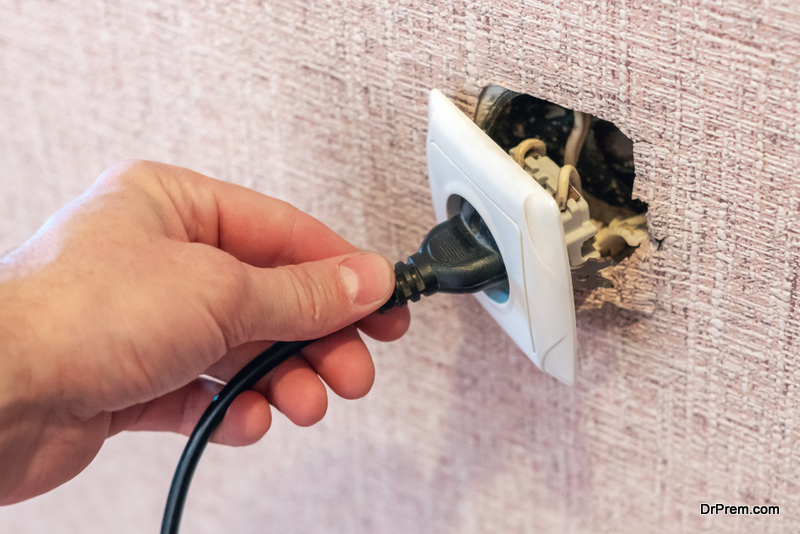Lights flickering or dimming for seemingly no reason?Mysterious damage to your outlets or switches?Power going out for no reason? No, you don’t have a ghost in the host. Instead, there’s a problem with your electrical service!
All these issues are signs of problems that electricians see all the time — especially in older homes.
In this article, we’ll start by exploring the three most common causes of electrical problems in older homes.
Then, we’ll connect those root causes to the issues you see happening in the house. Those would be things like the dimming or flickering lights that we mentioned before.
Finally, we’ll tell you what to do when you run into these problems. While we always recommend having an electrician handle any repairs, you can get a hard with a little detective work.
Common Causes of Electrical Problems In Older Homes
Problems with the power in your older home? The cause is probably one of these:
- Outdated Wiring
- Loose Connections
- New Appliances
1. Outdated Wiring
Some older homes still have “knob-and-tube” wiring. It’s a very outdated system — people stopped installing it back in the 1940s! It’s rare, but not unheard of, for an older home to still have a few of these lines running through the house.
But, there are two big problems with it.
First, this wiring went out of style before we had modern appliances — to say nothing of the many electronic devices in households today. These wires weren’t made to carry that much power.
Nex, there’s a fire risk if those wires are disturbed. They aren’t as secure or insulated as modern Romex wiring. If you’ve knocked through walls or moved things around in a ceiling, you may have shifted them.
Now, even older “modern” wiring can cause problems. THe insulation can wear off or the wires can get worn out. That all affects the current flowing to your appliances, lights, and electronics.
2. Loose Connections
Have you ever seen the back of a light switch or outlet, or installed one yourself? How about a ceiling fan? If so, you know that each device has a physical connection to the wires running from your electric panel.
In each case, someone had to physically screw in or clamp the wire to the device. Therefore, it’s possible that someone left a wire loose. Or it became unfastened over time — something’s that’s very possible if you’ve ever had a rodent problem. They love chewing and tugging in wires in your walls and ceiling.
EIther way, a loose connection can cause current problems. And, it increases the risk of a fire if the circuit isn’t complete. That’s when the electricity can jump from the wiring to your insulation or even your water pipes.
3. New Appliances
We mentioned how old knob-and-tube wiring usually can’t handle today’s electricity loads. Well, that’s especially the case when you upgrade old appliances. In fact, it can even happen with modern wiring if you don’t have the right service.
Today, you get 200 AMP service with a new or upgraded electrical panel. That’s enough power to run everything in the modern household. But, plenty of houses — especially ones that are a century old or older — still have old 100 AMP service.
Sometimes ,it’s not a problem. But, once you start plugging in more smart devices or try to add central air, you’ll start noticing those limitations.
Now, let’s get into the problems you’ll actually see happening in your home.
Flickering Lights
Flickering lights is a sign of an overloaded circuit or loose connection. You’re either getting an unsteady current, resulting in brief but constant losses of power.
Or, there are surges and the lights are reacting. Older bulbs may be burning too bright and then dimming back down. Newer bulbs or LED lights have limiters that may be trying to limit the amount of electricity coming to them.
How to Fix It
Start by unplugging anything you can in the room. Trying to draw too much electricity at once could be causing the surge. If your breaker keeps tripping even after you’ve turned things off, call an electrician. There’s a problem somewhere with the wiring.
Dimming Lights
Dimming lights mean the circuit can’t provide enough power to the room. What you’re seeing is not enough electricity to power everything. That means the bulbs burn less brightly than they should.
How to Fix It
Once again, turn off as many electronics, tools, and appliances as you can in the part of the house that’s affected. See if that helps. That may do the trick especially if you’ve recently started using more outlets in that room or area.
But, if it’s a new problem with no cause you can find, then once again there’s a big chance there’s a wiring issue. If just one part of the house is affected, it’s probably related to a single circuit.
If it’s widespread, or the power goes out in half the house, you’re more likely to have a bigger problem.
Circuit Breaker Keeps Tripping
A circuit breaker tips over and over again when the circuit is overloaded. That means a dangerous amount of electricity is trying to come through the panel and flow through your home.
The breaker acts as an interrupter — it halts the current before it causes a problem.
Some people think a breaker that keeps tripping is broken, but that’s not true! In fact, it’s working just fine and doing its job keeping you safe.
How To Fix It
Leave the breaker off and call your electrician. If it keeps tripping even after you turned off lights, appliances, and electronics, then there’s a problem somewhere in the wiring that’s causing an unsafe amount of electricity to come through the system. You need a professional to troubleshoot.
Warm Or Scorched Outlets or Switches
Warm or scorched fixtures are a severe sign of an overloaded circuit. By now, so much excess electricity has been coming through the lines that the wiring is overheating and causing the outlet and switches to get burned or start melting.
How to Fix It
Once again, turn off that breaker and call a professional! You’re running a big risk of a fire at this point. The wires in your walls are so warm that the insulation around them could catch fire.
Article Submitted By Community Writer




